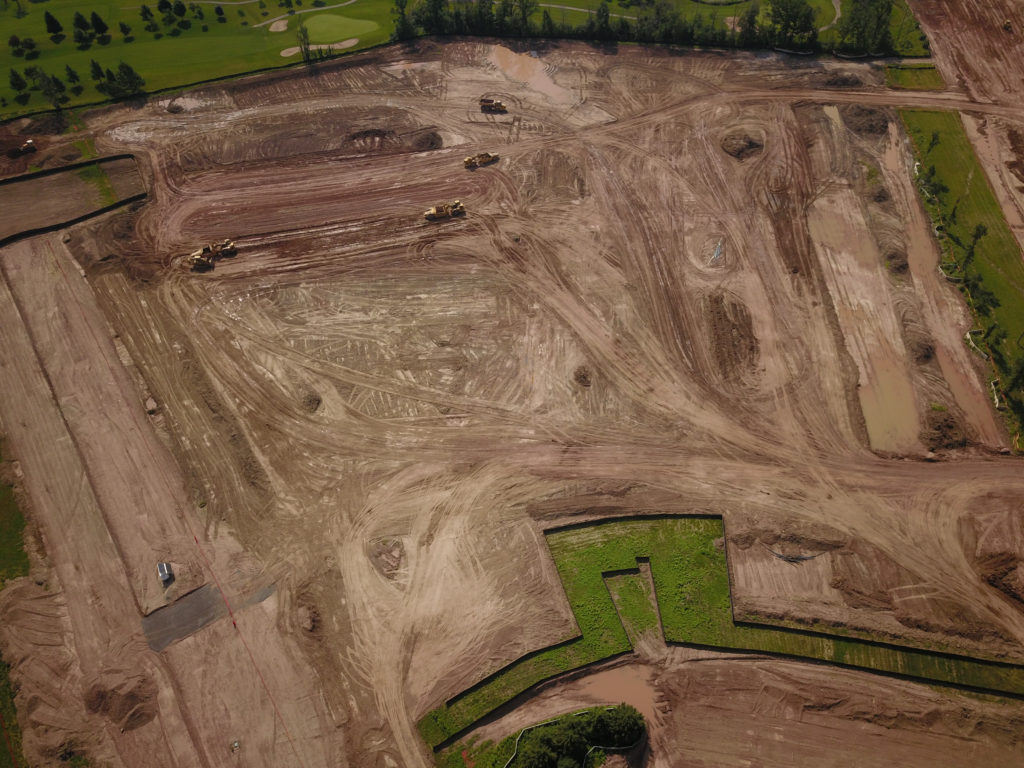Perhaps one of the most important elements of a land development project is the site grading design. A site grading design will allow a site contractor to know how to construct your project properly.
Site grading in construction is the actual moving around of earth by a site contractor to match the site grading plan that is a part of the overall land development plan. Site grading during construction usually refers to just the dirt that is moved around and not to the final grades (elevations) of impervious areas such as roads and driveways.
Site grading as referenced in a land development plan is the representation of what the proposed ground is supposed to look like after construction that is designed usually by a civil engineer. A site grading design would include final grades of both pervious and impervious areas. A grading design allows the engineer to show in a plan in two-dimensional form how a proposed layout should look with regard to elevations.
A grading design would show the elevation differences between proposed buildings and surrounding areas and should allow someone to determine the slope of the proposed ground surface at any point throughout the plan.
A site grading plan would most likely have to be reviewed for compliance with certain local regulations and approved by the local municipality before it can be used for construction.
Grading and Stormwater Management
A proper site grading design is especially important with regard to stormwater management. Any above-ground stormwater management system would require proposed grading to be shown on the grading plan so that the system can be constructed properly.
Also, the site grading would have to be designed to ensure that your proposed development drains stormwater runoff properly and that the stormwater management system functions correctly.
Advertisement
The Parts of a Site Grading Plan
The site grading plan that actually shows the full site grading design would contain the following parts.
1) Proposed contours – The majority of the proposed site grading would be represented by most likely solid contour lines and associated labels for the elevations of the contours.
2) Existing topography – The existing topography, including the existing contours, would have to be a part of the site grading plan in order to see how the proposed grading contours are to tie into the existing ground.
3) Existing buildings and other structures to be removed – These things would have labels to let the site contractor know what existing structures are meant to remain and which ones are to be removed as part of construction.
4) Existing trees to be removed as a part of construction – Individual trees could be labeled as having to be removed during construction. If a large group of trees is represented by a general tree line, a proposed tree line might be shown to let the site contractor know the extent of the removal of the existing trees.
5) Proposed layout – The site grading plan would also show the proposed layout of buildings, driveways, sidewalks, and other impervious areas.
6) Proposed storm drainage system layout – This would be shown to show how the proposed site grading will work to drain the different parts of your land development to the various inlets and pipes of the storm drainage system.
7) Limits of grading – The grading plan would also most likely have a line shown that delineates the limits of proposed grading. One reason for this is that how a land development plan is reviewed and how much review application fees cost could depend on the limit of the proposed grading.
Some Common Grading Slopes Used in Land Development
One common thing among grading plan designs is that the design engineer most likely has to comply with certain minimum and maximum grading slopes as specified by applicable regulations.
For pervious ground cover such as lawn areas, a common minimum grading slope is one percent to allow for proper stormwater drainage. A common maximum grading slope is 25 percent (or a one-foot vertical elevation change over a four-foot horizontal distance change) for safety reasons.
For a driveway, a common minimum slope is one percent and a common maximum slope is 15 percent.
Related: What Is a Typical Driveway Slope?
You might even see labels for proposed slopes on the plan either over certain areas or pointing to certain areas so that it is a little clearer to someone using the plan what that areas are supposed to look like after construction.
Spot Grading
In addition to the use of contour lines to show proposed grading, proposed spot grading can be used within a site grading design.
Proposed spot grades (also often referred to as spot elevations) are specific points on a plan labeled with proposed elevations. These individual points are used in areas of the plan that might require more grading detail or where clarification is required for the site contractor to know where proposed high points and low points are supposed to be located.
Even though proposed spot grades can be found in pervious areas, they are especially common in impervious areas such as parking areas because of the extra detail that could be required to construct these areas.
Advertisement
Earthwork Analysis
Another reason a site grading design is created for a land development plan is that it is used as the basis for an earthwork analysis.
An earthwork analysis for a construction project is the comparing of the amount of earth that is cut from the existing ground to the amount of earth that is filled over the existing ground.
A common goal of civil engineers with regard to designing a land development plan is to create a site grading design that balances. A site that balances is a site with a proposed site grading design that has an earth cut amount that is equal to the earth fill amount. A site that balances would eliminate the requirement for extra earth to either have to be taken away from the site or have to be imported into the site.
Even when a site does not balance, an earthwork analysis can still be used for construction planning with regard to determining the amounts of either the extra cut material that can be expected to be taken away from the site or the extra fill material that can be expected to be imported into the site throughout construction.
An accurate earthwork analysis can be done only after a site grading design is created.
A Major Component of a Land Development Plan
The site grading plan is only one component of the overall land development plan but it is a major component. It is this plan that allows your land development to be accessible, to drain properly, and to comply with all applicable regulations.
Without a proper site grading design, your land development project would be very difficult to build.



